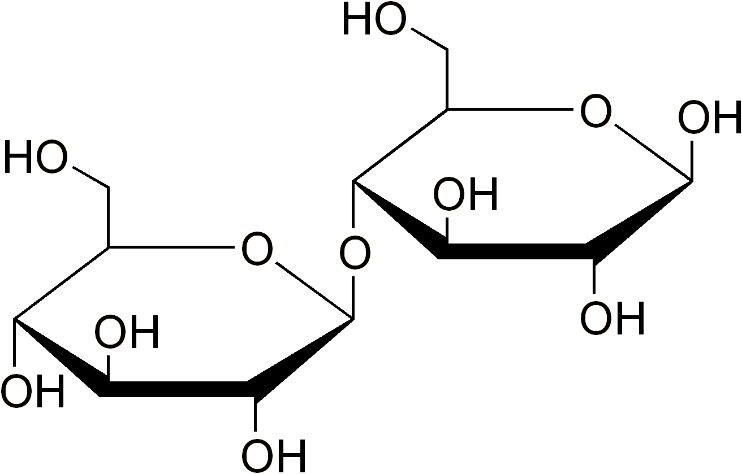
Answer
441.9k+ views
Hint: Cellobiose is a disaccharide that is formed when the first carbon of a monosaccharide and the fourth carbon of another monosaccharide condense to release water and forms a glycosidic bond.
Complete answer: Cellobiose is also known as \[GLCB1{\text{}}-{\text{}}4GLCB\]. This compound belongs to a group of organic compounds known as o-glycosyl compounds. In this compound, a sugar molecule is bonded through one carbon to another group via a glycosidic bond. It commonly exists in all eukaryotes ranging from yeast to humans. It is a disaccharide. It is a type of reducing sugar i.e. it can be enzymatically hydrolyzed to a monosaccharide. It is derived by the condensation of two $\beta-$ glucose molecules forming \[\beta(1\to 4)\] glycosidic bonds. It has eight free OH groups. It is made up of $\beta-D$ glucopyranosyl and glucopyranose molecules. It has an acetal and hemiacetal linkage that gives rise to strong intramolecular and intermolecular bonds. Its scientific name is $4-\beta-D-$ glucopyranosyl-D-glucose. It is commonly used as a sweetening agent and is formed as a fermentable intermediate in brewing. It is commonly used as an indicator of Crohn's disease and malabsorption syndrome.
Hence, the correct answer is option A.

Note: Cellulose is a white crystalline disaccharide that performs a structural role and is present in several organisms. It is formed when cellobiose partially breaks down by the enzyme cellulase. It is similar to cellulose in having glucose constituents. Its chemical formula is ${C_{12}}{H_{22}}{O_{11}}$.
Complete answer: Cellobiose is also known as \[GLCB1{\text{}}-{\text{}}4GLCB\]. This compound belongs to a group of organic compounds known as o-glycosyl compounds. In this compound, a sugar molecule is bonded through one carbon to another group via a glycosidic bond. It commonly exists in all eukaryotes ranging from yeast to humans. It is a disaccharide. It is a type of reducing sugar i.e. it can be enzymatically hydrolyzed to a monosaccharide. It is derived by the condensation of two $\beta-$ glucose molecules forming \[\beta(1\to 4)\] glycosidic bonds. It has eight free OH groups. It is made up of $\beta-D$ glucopyranosyl and glucopyranose molecules. It has an acetal and hemiacetal linkage that gives rise to strong intramolecular and intermolecular bonds. Its scientific name is $4-\beta-D-$ glucopyranosyl-D-glucose. It is commonly used as a sweetening agent and is formed as a fermentable intermediate in brewing. It is commonly used as an indicator of Crohn's disease and malabsorption syndrome.
Hence, the correct answer is option A.

Note: Cellulose is a white crystalline disaccharide that performs a structural role and is present in several organisms. It is formed when cellobiose partially breaks down by the enzyme cellulase. It is similar to cellulose in having glucose constituents. Its chemical formula is ${C_{12}}{H_{22}}{O_{11}}$.
Recently Updated Pages
Write the IUPAC name of the given compound class 11 chemistry CBSE

Write the IUPAC name of the given compound class 11 chemistry CBSE

Write the IUPAC name of the given compound class 11 chemistry CBSE

Write the IUPAC name of the given compound class 11 chemistry CBSE

Write the IUPAC name of the given compound class 11 chemistry CBSE

Write the IUPAC name of the given compound class 11 chemistry CBSE

Trending doubts
Fill the blanks with the suitable prepositions 1 The class 9 english CBSE

Which are the Top 10 Largest Countries of the World?

How do you graph the function fx 4x class 9 maths CBSE

Distinguish between the following Ferrous and nonferrous class 9 social science CBSE

The term ISWM refers to A Integrated Solid Waste Machine class 10 social science CBSE

The Equation xxx + 2 is Satisfied when x is Equal to Class 10 Maths

Difference between Prokaryotic cell and Eukaryotic class 11 biology CBSE

Which is the longest day and shortest night in the class 11 sst CBSE

In a democracy the final decisionmaking power rests class 11 social science CBSE




